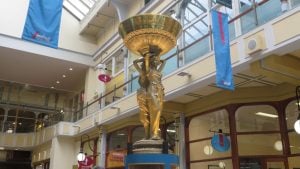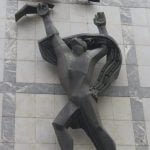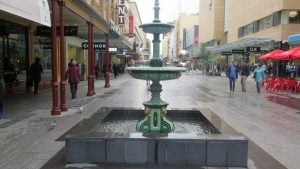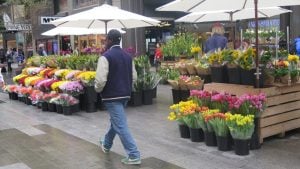Beehive Corner and the start of Rundle Mall
15 June 2015
Today I arrived in the beautiful capital of South Australia, Adelaide, for a WEEAD (World Elder Abuse Awareness Day) Conference. It was drizzling rain in the middle of the day when I left the airport, but by the time the taxi reached the hotel it had stopped raining and stayed fine and mainly sunny for the rest of the day.
I was armed with the Rundle Mall Walking Trail and planned to follow it during the afternoon as it was the only time I would have to explore the city before the conference. This was only my second quick visit to Adelaide, the first was when I had an afternoon stopover during the journey on the Indian Pacific to Perth last year. We had taken a city tour that included Glenelg, but it was just a flying visit.
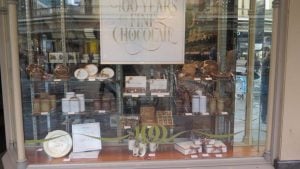 My hotel was only two blocks from the beginning of the Mall, and the impressive Beehive Building (above) that welcomes you to explore the arcades, shops, street art and everything else that makes the Mall an interesting place to be. The Beehive Building (with a gold bee on the roof) was built in 1895/97 in a Gothic Revival style. Yes, I did wander past the famous Haigh’s Chocolate Shop (left) but resisted temptation!
My hotel was only two blocks from the beginning of the Mall, and the impressive Beehive Building (above) that welcomes you to explore the arcades, shops, street art and everything else that makes the Mall an interesting place to be. The Beehive Building (with a gold bee on the roof) was built in 1895/97 in a Gothic Revival style. Yes, I did wander past the famous Haigh’s Chocolate Shop (left) but resisted temptation!
I explored two of the older arcades, the restored Regent Arcade, and Adelaide & Gay’s Arcades and decided to have a late lunch there. The Adelaide Arcade with its adjoining Gay’s Arcade was built in 1885, the facades are Italianate style, and was the first retail outlet in Australia to have electric lighting.
The Regent Arcade, formerly the Regent Theatre opened in 1928, it had an orchestra pit large enough to cater for a full size orchestra. In 1967 the building was modified to include food and fashions shops and in 2006 the theatres were removed.
Street art is everywhere in the Rundle Mall, one of the first you come across is the bronze sculptures of the four pigs, Truffles, Horatio, Oliver and Augusta made by Marguerite Derricort and unveiled in July 1999. “The Spheres”, (sometimes called “Mall’s Balls”) are by Bert Flugelman and were erected in 1977 and is a special meeting place for visitors.
The welded copper sculpture “Progress” by Lyndon Dadswell was created in 1959 and in 1963 attached to the front of the then new David Jones building. Very impressive!
And it wouldn’t be a mall without the young buskers!
The Rundle Mall Fountain was first cast in the late 1800s and has been moved several times. It is now in front of the Adelaide Arcade and has been painstakingly repainted in the colours of the Victoria era.
Turning left at the end of the Mall into Pulteney Street, on the left hand side one can see the Ruthven Apartments, Scots Church and Bonython Hall in the grounds of Adelaide University.
The Ruthven Apartments was built in two stages between 1911 and 1914 and were the first apartments with “mod cons” such as electric lighting and mechanical ventilation. Renovated in 1970 the building now contains attractive apartments and a shopping arcade.
Scots Church on the corner of North Terrace was built for the Presbyterian Free Church in 1850 and is one of the oldest remaining churches in the city. The spire was added in 1856.
 Bonython Hall in the grounds of Adelaide University was built in 1936 with a donation of 40,000 pounds from Sir John Langdon Bonython, owner of the Advertiser newspaper. He wanted the University to have a hall like Oxford and Cambridge universities – but there were two stipulations. One was where the building was to be erected, and the second was that it had a sloping floor to discourage dancing!
Bonython Hall in the grounds of Adelaide University was built in 1936 with a donation of 40,000 pounds from Sir John Langdon Bonython, owner of the Advertiser newspaper. He wanted the University to have a hall like Oxford and Cambridge universities – but there were two stipulations. One was where the building was to be erected, and the second was that it had a sloping floor to discourage dancing!
North Terrace is also the home of the Art Gallery, the Museum, King Edward VII statue, National War Memorial, the Statue of Venus, and the Walk of Fame.
The Art Gallery was established in 1881, with subsequent wings added later. The Gallery contains the country’s most significant and important collections of 19th century Australian paintings and Aboriginal Western Desert Dot paintings are housed here.
The South Australian Museum was moved to its current site in 1884, with many additions since then to house the growing collections. The Australian Aboriginal Cultures Gallery houses the world’s most comprehensive Aboriginal Cultural Exhibition.
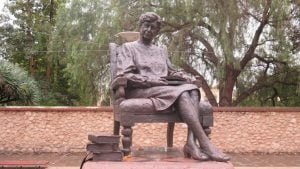 The Walk of Fame commemorates the high achievers of the State, one of those being Dame Roma Mitchell. She was born in Adelaide in 1913 and graduated as a lawyer in 1934, became a barrister the following year, and in 1965 became the first woman to be appointed a Judge of the South Australian Supreme Court. In 1991 Dame Roma was appointed as the first woman Governor of the State – truly a great achiever.
The Walk of Fame commemorates the high achievers of the State, one of those being Dame Roma Mitchell. She was born in Adelaide in 1913 and graduated as a lawyer in 1934, became a barrister the following year, and in 1965 became the first woman to be appointed a Judge of the South Australian Supreme Court. In 1991 Dame Roma was appointed as the first woman Governor of the State – truly a great achiever.
Colourful Street Art and scenes in and around Rundle Mall –
Roy “Mo” Rene
I really enjoyed my short stay in Adelaide, and look forward to another quick visit at the end of my adventure in the Northern Territory in July.


